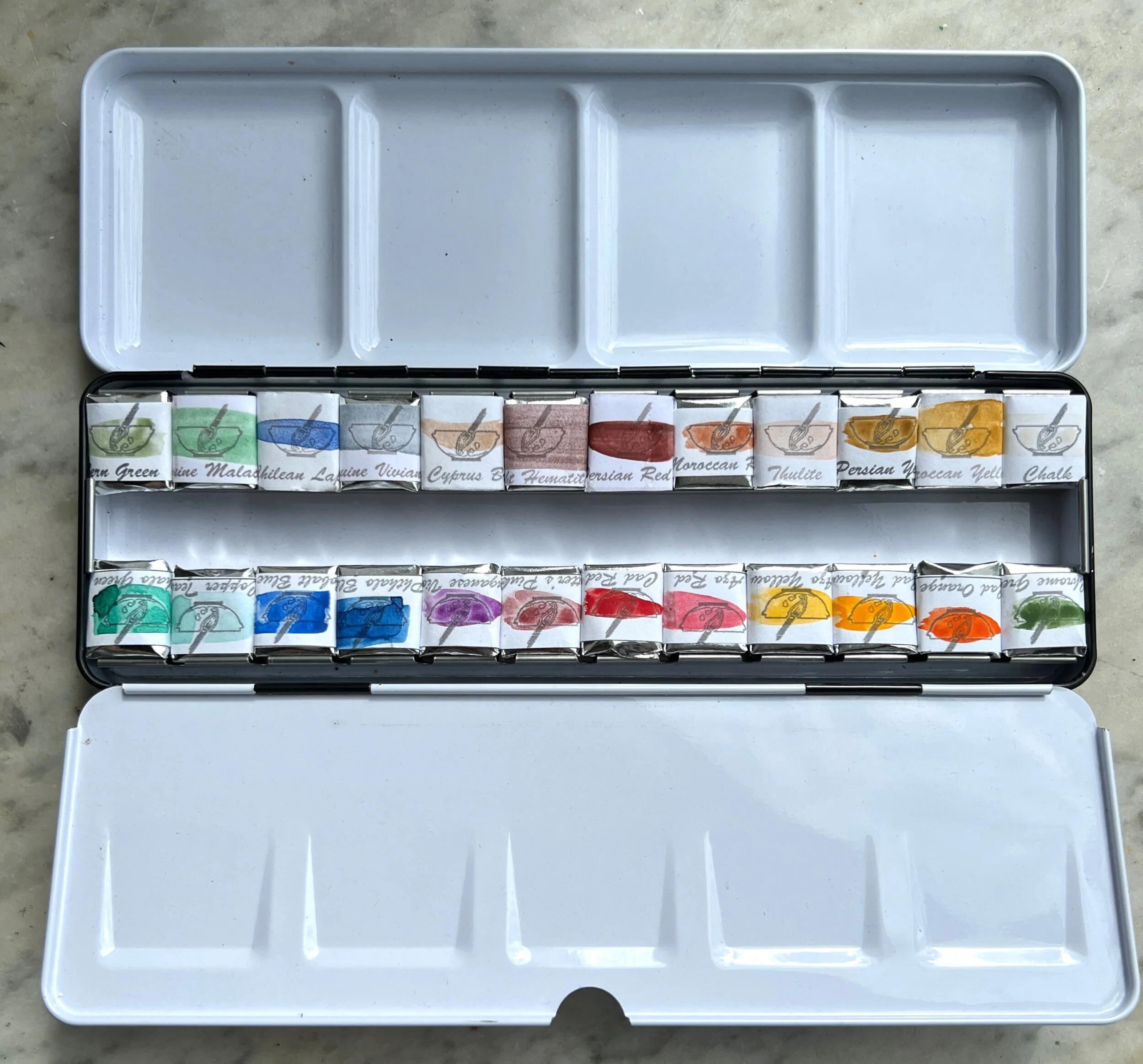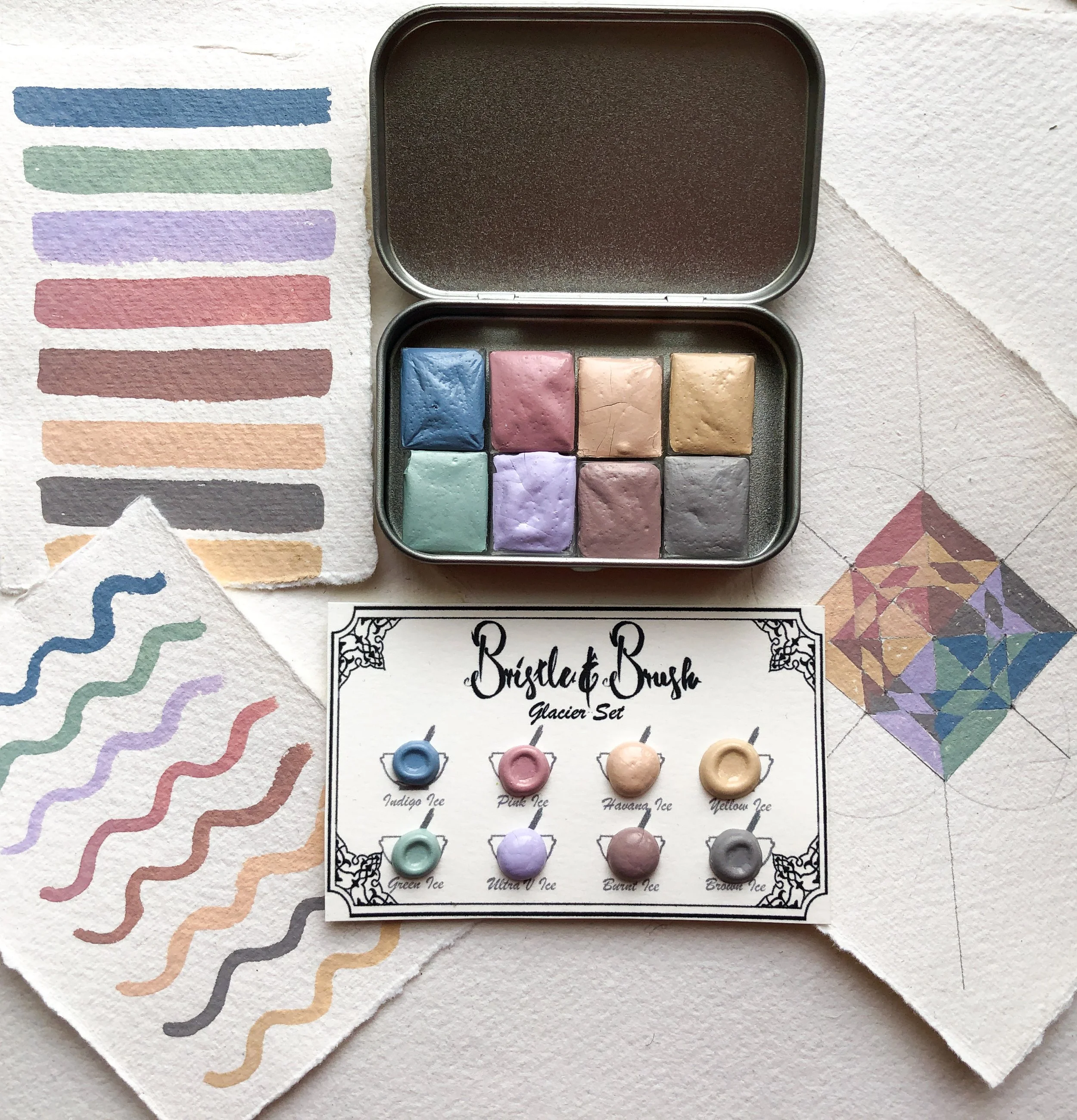Sustainable Watercolour Pans
With the rapid changes in our climate and the emergency state that our planet is under, I am thinking of more ways to be sustainable in my life in general and in art. It’s sometimes easy to forget that being sustainable is more than abandoning plastic bags and one use straws and cutlery, so in this post I am turning to sustainability in art and tackling the watercolour pans.
In my artistic practice, I use a specific set of tools consistently: watercolours in pans and tubes, brushes and paper. The issue with watercolour pans and the main turn off was that they are made of plastic. I didn’t think of it much at first because I am forever repurposing those pans even after the paint is finished, but the fact that those pans will remain in the planet way after I am gone haunts me sometimes. Thus, I started looking at all possible alternatives to try to minimise my impact. I know that changing the materials of my pans isn’t going to solve the climate crisis, but at least it’s one step in the right direction. This approach is one of the reasons I started making my own paints in zero-plastic containers.
Looking back at old vintage watercolour palettes and sets that were made before plastic was invented is a great inspiration and it is noticeable that they used three types of pans: metal pans, wooden pans and ceramic pans. The old ways are sometimes better and kinder to the environment. Sadly, it is kind of rare to see watercolours in natural containers especially after plastic became the norm. This is why it’s so heartwarming seeing micro paint makers inventing new ways to be sustainable
Using Sea Shells instead
Sea shells are such a great alternative to plastic and they are one of the oldest natural containers that we have. A lot of people seem to be surprised with using shells, but Muslim artists have used them for centuries to hold their natural pigments hence the term shell gold, where the genuine fine gold that was used to paint Islamic manuscripts since the 12th century (possibly earlier) was stored. There aren’t many self portraits of Eastern (Persian/Mughal) artists that show the tools, but there are a few I came across and here is an example and you can the mussel shells filled in colour and laid out in front of the artists. So, seashells are revived directly from history.
Mussel shells are IDEAL for paint because of their large surface and you know that some Mughal (Indian) artists use their index finger to remix the paint with water! I usually use them when I make paint for myself and I want a bigger quantity. However, those mussel shells can break in transport, so I have offered the smaller more contained shells instead and they look super cute!
The only downside with filling a shell is that it sometimes lacks stability and then half the paint pours out in the making. Funnily, I don’t have that issue painting with the shells just when I pour the liquid paint into them.
Look at all the big and colour-filled shells I use for my own work :D
Using metal pans instead
Sourcing shells when I don’t live near the beach is not the easiest thing for me and since they are all natural, it is hard to control their size and capacity, so, I tried to find a metal pan container and oh boy, I bought so many different ones to achieve what I wanted. I know watercolourists don’t like metal sometimes because of rust, but if it’s sealed properly from the get go then it will be absolutely fine with the use of water. I couldn’t make my mind up regarding the shape of circle vs square, so I am supplying both at the moment. The main pro is that it is plastic free and it is a wider surface to move the brush. The con however is that they are not “standard” size that people are used to, which makes selling them sometimes challenging because they are larger than the norm, but flat-ish at the same time giving the impression that might be smaller, when in fact they are doable the usual capacity.
Basically, the “standard” watercolour pan was made-up by the watercolour companies, so there are some small differences based on the brand, which makes the size slightly different (we are talking mm), but the VOLUME is the thing that is mostly consistent for each brand. The usual volume for a half pan 1.5 to 1.6 ml and this is the most common size that most people use and it is fabulous for smaller pieces, but if you are working big and with watercolour then you need a FULL pan that is double the size, so ranges between 3-3.6 ml and that is the capacity of my metal pans, which makes them a bargain if I say so myself lol. Regardless of volume, they make a great plastic alternative!
Using PLA biodegradable pans instead
If you are not a fan of the metal pans because they want all your pans to fit with previous tins, boxes and collections, then the PLA biodegradable pans are a good midway solution and more paint-makers are using them at the moment.
Coming soon! So get on the newsletter to be notified when they are available
PLA means Polylactic Acid and it is made from corn starch, sugar cane, tapioca and other plant-based material. The great thing about it is that it can have similar properties to plastic without the petroleum content. Also, fun fact, these PLA pans are PRINTED using a 3D printer.
They are the size we are all used to, they are small enough to price in an affordable way and some people prefer them.
The only issue with PLA is that not a lot of recycling centres can recycle it and you will have to check locally how you can recycle it. There are a few debates going on about using it as a material and the internet has all the possible opinion on the subject, but it comes down to you and your sustainability approach and what you think is more important.
I am hoping to offer return option on these, so I can either re-fill them or send them to the proper recycling plant, but then that raises the issue of shipping footprint and so on. Sustainability is actually a hard subject, but we are all trying!
Using ceramic palettes instead
Nothing beats ceramic, well it’s just heavy to ship internationally, but other than that, it is actually a very fun and really sustainable material and it fits so well with ochers. Imagine that, ochers from the earth going into ceramic from clay. It is poetic. The only issue with these is the capacity of the wells because you get the equivalent of one or two full pans in there and that might increase the price of it more, but it is still worth it. Also, you can reuse these as mixing palettes when the paints are finished.
Sold out at the moment, but will let you know in the newsletter when they are available
Using wooden palettes instead
Everything looks great made from beautiful solid wood and it is actually sad that we lost the craftsmanship of wooden objects in our everyday life and in art supplies. Imagine having one of these lovely vintage wood set rather than a plain boring plastic. On one hand, you don’t want trees to be chopped, but on the other, they are the best sustainable solution. It is important that you chat with the providers of wooden palettes to make sure they are sustainable sourced and not from protected woodland.
I don’t have my own images with these, but offering wooden palette is up there on the wish list and I have been chatting with my husband about making it happen. I am not sure when we will get that going, but I will send you a notification on the newsletter as soon as this is an option.
Hope you find this post useful and I can’t wait for you to try some of the plastic-free watercolour sets I have on offer for you :D
Shop Bristle and Brush Paints:


























